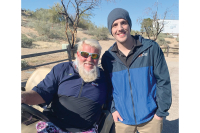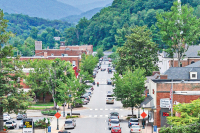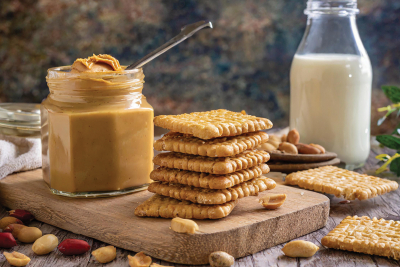Cataloochee Ranch plants seed for mighty tree to thrive once more
A collaborative effort between The American Chestnut Foundation and the Coker family has put Cataloochee Ranch in Maggie Valley on the frontlines of the effort to reintroduce a tree that was integral to life of early settlers in Western North Carolina.
Before a devastating airborne disease arrived on U.S. soil in the early part of the 20th century, the American chestnut tree ruled more than 200 million acres of woodlands that stretched the length of the Appalachian Mountains. An estimated four billion American chestnuts grew in that range, nearly a quarter of the entire hardwood population.
The Chestnut blight—a fungus that enters the bark of damaged trees—came to the country on ornamental Chinese chestnuts. Durning the first half of the century, it wiped out nearly the entire population of American chestnuts, which had no inborn resistance to the disease.
Since 1989, The American Chestnut Foundation, a group founded by prominent plant scientists, has been working to create a blight-resistant strain of trees that retains the characteristics of the American chestnuts that once ruled the Eastern Woodlands — but has just enough of the Chinese chestnut strain to make it blight resistant. The effort began at the Foundation’s experimental farm in Meawdowbrook, Va., but as the scientists began to develop the third generation of their crossed trees, they also branched out to satellite farms that could represent the diverse terrain and climate characteristics of the American chestnut’s historic territory.
For Judy Coker, who grew up at Cataloochee Ranch when giant chestnuts still loomed on the hillsides, being involved in the reintroduction effort is special.
“It’s something you could call almost romantic,” She said. “You remember it in the past and you have all your hopes built up on the future. To be a part of it is really important.”
Related Items
Judy Coker, known to most as Miss Judy, has been on the board of The American Chestnut Foundation’s Carolinas Chapter, and has passed that role on to her daughter, Judy Sutton.
In the mountains only the older generation remembers what chestnuts were like in their glory, and Miss Judy’s recollections of healthy trees are fleeting.
“The one memory I have—and I was probably 6 years old—was going to the Purchase, which is a huge open pasture,” Miss Judy said. “I remember there were six huge trees in the open field, and they were spread out wide. We went to pick the chestnuts, and they were just everywhere.”
The chestnut
past and present
The American chestnut was perhaps more important to the economy of Western North Carolina than to any other area in its range. A late-flowering and extremely productive tree, immune to seasonal frosts, the American chestnut was the single most important food source for wildlife, from bears to deer to birds.
Mountain communities depended upon the annual chestnut harvest as a cash crop and as a primary source of forage for their livestock, which were turned lose in the chestnut forests to gorge themselves and fatten up before the harvest.
In addition, chestnut wood split straight and was rot resistant, making it ideal for everything from fence posts and barn frames to coffins and shingles.
“The mountain people took the chestnut for granted because it was used for everything from the cradle to the grave,” said Richard Coker, whose grandparents started Cataloochee Ranch.
Cataloochee Ranch is a rugged outdoor resort on expansive mountaintop acreage near Maggie Valley, dating to the 1930s. Even though the chestnuts were already dying, much of the ranch was built with wood from the still standing but dead trees.
In 2007, Dr. Paul Sisco, a plant geneticist and Chestnut Foundation board member, helped the Cokers plant 320 trees, representing three strains of North Carolina American chestnut stock, on a hill above the Cataloochee Ranch.
“We are a conservation business so the chestnuts just fit right into that,” Richard Coker said. “I, as well as many other people, took the chestnuts for granted. When they died we realized how important they were.”
Now 4-years-old, the trees are still two or three years away from blooming. Before they reach blooming age, which is when the blight begins to infect trees, they will be inoculated with measured doses of the disease. Unfit trees will be culled, and the resistant trees crossbred again.
Sisco said the Haywood County location and its high elevation were a perfect site for the experimental grove for both historical and biological reasons. Historically, Western North Carolina was third in the country in terms of chestnut acreage behind Pennsylvania and West Virginia, and the largest chestnut ever recorded was cut in Haywood County in Francis Cover before 1915. That giant tree measured 17 feet in diameter — or approximately 53 feet around.
“The best land for reintroduction of chestnuts is really the high mountains because it’s the best topsoil left,” Sisco said.
Mountain natives know that certain names for hills are ubiquitous. Cold Mountain, Black Mountain and Balsam Mountain are names derived from common characteristics. So, too, is the name Yellow Mountain, which Sisco said originated from chestnut covered hilltops in June, when their yellow flowers color the landscape.
The American chestnut was significant to the local economy in Haywood County even after the blight had killed the trees. According to Sisco, who has researched the tree’s uses in detail, the wood of dying trees insulated Champion Paper Company from the Depression. Until 1951, Champion operated a chestnut extract plant that used the high tannin content—up to 11 percent dry, white tannin—to process tanning agents for local tanneries.
Chestnuts are naturally resistant to frost and like well-drained soil. While Cataloochee Ranch’s 5,000 foot altitude is just at the high end of the chestnuts preferred range, the trees their have been thriving. Another benefit of the altitude is that it reduces the threat of a root rot, called phytopthora, that doesn’t do well in colder temperatures.
“We’ve had a tremendous survival rate up here,” Sisco said of the three strains planted from seed.
The American Chestnut Foundation’s backcross breeding program took Chinese chestnut trees, naturally resistant to the blight, and crossed them with their American cousins, resulting in trees that were half American and half Chinese. The offspring were backcrossed to the American species twice more to produce an American chestnut tree that retained no Chinese characteristics other than blight resistance.
The trees at Cataloochee come from three distinct North Carolina mother trees being crossed with Asian trees. There are 44 experimental chestnut orchards in Western North Carolina, but the Cokers’ is the second biggest and by far, the most visible.
Richard Coker helped put the seeds in the ground, and he said watching the seedlings grow has shown him the power of the American chestnut tree.
“I’ve learned what a dominant species they are,” Richard Coker said. “ We have 4-year-old trees that are over my head. They just love the mountaintops.”
Sisco stops short of saying that the reintroduction of the American chestnut is sure to succeed, but he said the Foundation’s scientists will continue to produce better varieties of American chestnut until they have surviving adult trees that are capable of living free.
“What’s going to happen is we are going to have better materials coming along all the time. People are just going to have to be patient,” Sisco said.
In September, the Cokers will host Chestnut Saturday at Cataloochee Ranch, a fundraiser for the Carolinas Chapter of TACF, and a national gathering of chestnut scientists.
For Richard Coker, the events will mark a milestone on the way to a monumental victory.
“I would hope that within my daughter’s lifetime the chestnuts will be free-ranging,” Richard Coker said.
For more information, go to www.acf.org.













